
莲喇母矮将贸多大学 高级商务英语阅读 Supplementary Reading for Chapter 13 M&A:Companies Shopped-Now They've Dropped CEO Dialogue:A discussion with CEOs on key business and management themes shaping their organization's interaction with its external environment and relationship with key stakeholders. Synergies:the how and why of mergers/acquisitions Mergers and acquisitions(M&A)continue to be an important strategic option for many companies. Access to new markets,cost savings through shared services,and recapitalising a business are all attractive options for corporate strategists.While the conceptual appeal of M&A is undeniable,it is the success of the post-deal business integration that really makes or breaks the strategic play. One Australian CEO with deep experience in M&A is SPC Ardmona's Managing Director,Nigel Garrard.As Chief Executive Officer for the entity formed from the merger between SPC and Ardmona Foods late last year,Garrard has seen at first hand the challenges and difficulties in both planning a merger and getting it to work in practice.Prior to coming to SPC in 2000,Garrard also oversaw the rapid growth of Chiquita Foods in Australia,growth in which targetted acquisitions was a key feature In this interview with ceoforum.com.au's Mike Riddiford.Garrard talks about when M&A can be the right strategic option,how strategic fit can be assessed,and what CEOs need to do to make the newly-formed businesses work. Mike:What's driving M&A activities now?Is it simply about cost/economies of scale in a more competitive economy? Garrard:If I look at our own industry,scale has always been important.Obviously having a larger revenue base to sustain overseas market entry,branding activities,R&D,competitive pricing and so on will give you those efficiencies.This has always been the case,of course,but ongoing globalization of markets is making scale even more imperative. 第1页共7页
高级商务英语阅读 Supplementary Reading for Chapter 13 M & A: Companies Shopped—Now They’ve Dropped CEO Dialogue: A discussion with CEOs on key business and management themes shaping their organization’s interaction with its external environment and relationship with key stakeholders. Synergies: the how and why of mergers/acquisitions Mergers and acquisitions (M&A) continue to be an important strategic option for many companies. Access to new markets, cost savings through shared services, and recapitalising a business are all attractive options for corporate strategists. While the conceptual appeal of M&A is undeniable, it is the success of the post-deal business integration that really makes or breaks the strategic play. One Australian CEO with deep experience in M&A is SPC Ardmona's Managing Director, Nigel Garrard. As Chief Executive Officer for the entity formed from the merger between SPC and Ardmona Foods late last year, Garrard has seen at first hand the challenges and difficulties in both planning a merger and getting it to work in practice. Prior to coming to SPC in 2000, Garrard also oversaw the rapid growth of Chiquita Foods in Australia, growth in which targetted acquisitions was a key feature. In this interview with ceoforum.com.au's Mike Riddiford, Garrard talks about when M&A can be the right strategic option, how strategic fit can be assessed, and what CEOs need to do to make the newly-formed businesses work. Mike: What's driving M&A activities now? Is it simply about cost/economies of scale in a more competitive economy? Garrard: If I look at our own industry, scale has always been important. Obviously having a larger revenue base to sustain overseas market entry, branding activities, R&D, competitive pricing and so on will give you those efficiencies. This has always been the case, of course, but ongoing globalization of markets is making scale even more imperative. 第 1 页 共 7 页
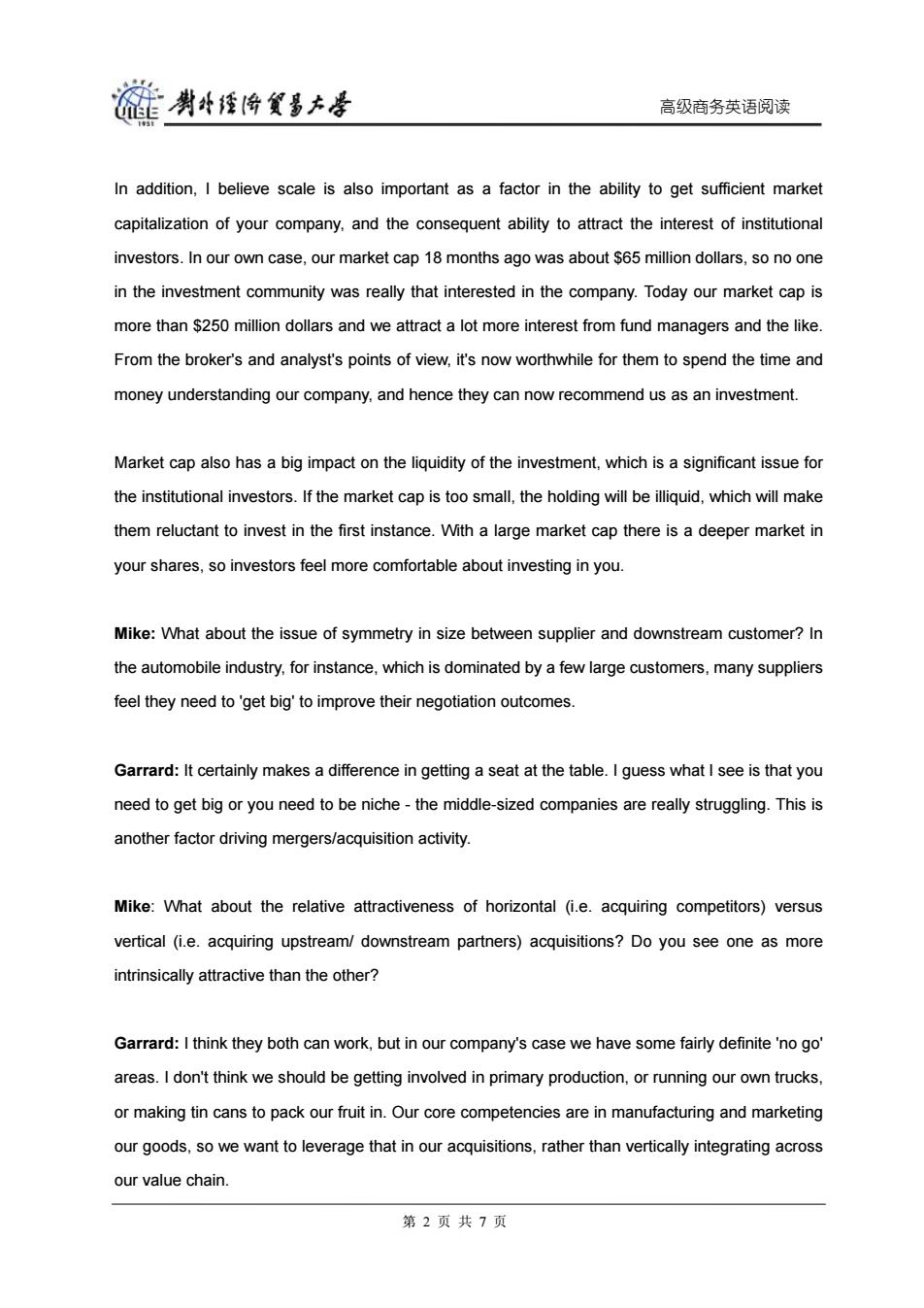
能男华经降贸多大星 高级商务英语阅读 In addition,I believe scale is also important as a factor in the ability to get sufficient market capitalization of your company.and the consequent ability to attract the interest of institutional investors.In our own case,our market cap 18 months ago was about $65 million dollars,so no one in the investment community was really that interested in the company.Today our market cap is more than $250 million dollars and we attract a lot more interest from fund managers and the like. From the broker's and analyst's points of view,it's now worthwhile for them to spend the time and money understanding our company,and hence they can now recommend us as an investment. Market cap also has a big impact on the liquidity of the investment,which is a significant issue for the institutional investors.If the market cap is too small,the holding will be illiquid,which will make them reluctant to invest in the first instance.With a large market cap there is a deeper market in your shares,so investors feel more comfortable about investing in you. Mike:What about the issue of symmetry in size between supplier and downstream customer?In the automobile industry,for instance,which is dominated by a few large customers,many suppliers feel they need to 'get big'to improve their negotiation outcomes. Garrard:It certainly makes a difference in getting a seat at the table.I guess what I see is that you need to get big or you need to be niche-the middle-sized companies are really struggling.This is another factor driving mergers/acquisition activity. Mike:What about the relative attractiveness of horizontal (i.e.acquiring competitors)versus vertical (i.e.acquiring upstream/downstream partners)acquisitions?Do you see one as more intrinsically attractive than the other? Garrard:I think they both can work,but in our company's case we have some fairly definite 'no go' areas.I don't think we should be getting involved in primary production,or running our own trucks, or making tin cans to pack our fruit in.Our core competencies are in manufacturing and marketing our goods,so we want to leverage that in our acquisitions,rather than vertically integrating across our value chain. 第2页共7页
高级商务英语阅读 In addition, I believe scale is also important as a factor in the ability to get sufficient market capitalization of your company, and the consequent ability to attract the interest of institutional investors. In our own case, our market cap 18 months ago was about $65 million dollars, so no one in the investment community was really that interested in the company. Today our market cap is more than $250 million dollars and we attract a lot more interest from fund managers and the like. From the broker's and analyst's points of view, it's now worthwhile for them to spend the time and money understanding our company, and hence they can now recommend us as an investment. Market cap also has a big impact on the liquidity of the investment, which is a significant issue for the institutional investors. If the market cap is too small, the holding will be illiquid, which will make them reluctant to invest in the first instance. With a large market cap there is a deeper market in your shares, so investors feel more comfortable about investing in you. Mike: What about the issue of symmetry in size between supplier and downstream customer? In the automobile industry, for instance, which is dominated by a few large customers, many suppliers feel they need to 'get big' to improve their negotiation outcomes. Garrard: It certainly makes a difference in getting a seat at the table. I guess what I see is that you need to get big or you need to be niche - the middle-sized companies are really struggling. This is another factor driving mergers/acquisition activity. Mike: What about the relative attractiveness of horizontal (i.e. acquiring competitors) versus vertical (i.e. acquiring upstream/ downstream partners) acquisitions? Do you see one as more intrinsically attractive than the other? Garrard: I think they both can work, but in our company's case we have some fairly definite 'no go' areas. I don't think we should be getting involved in primary production, or running our own trucks, or making tin cans to pack our fruit in. Our core competencies are in manufacturing and marketing our goods, so we want to leverage that in our acquisitions, rather than vertically integrating across our value chain. 第 2 页 共 7 页
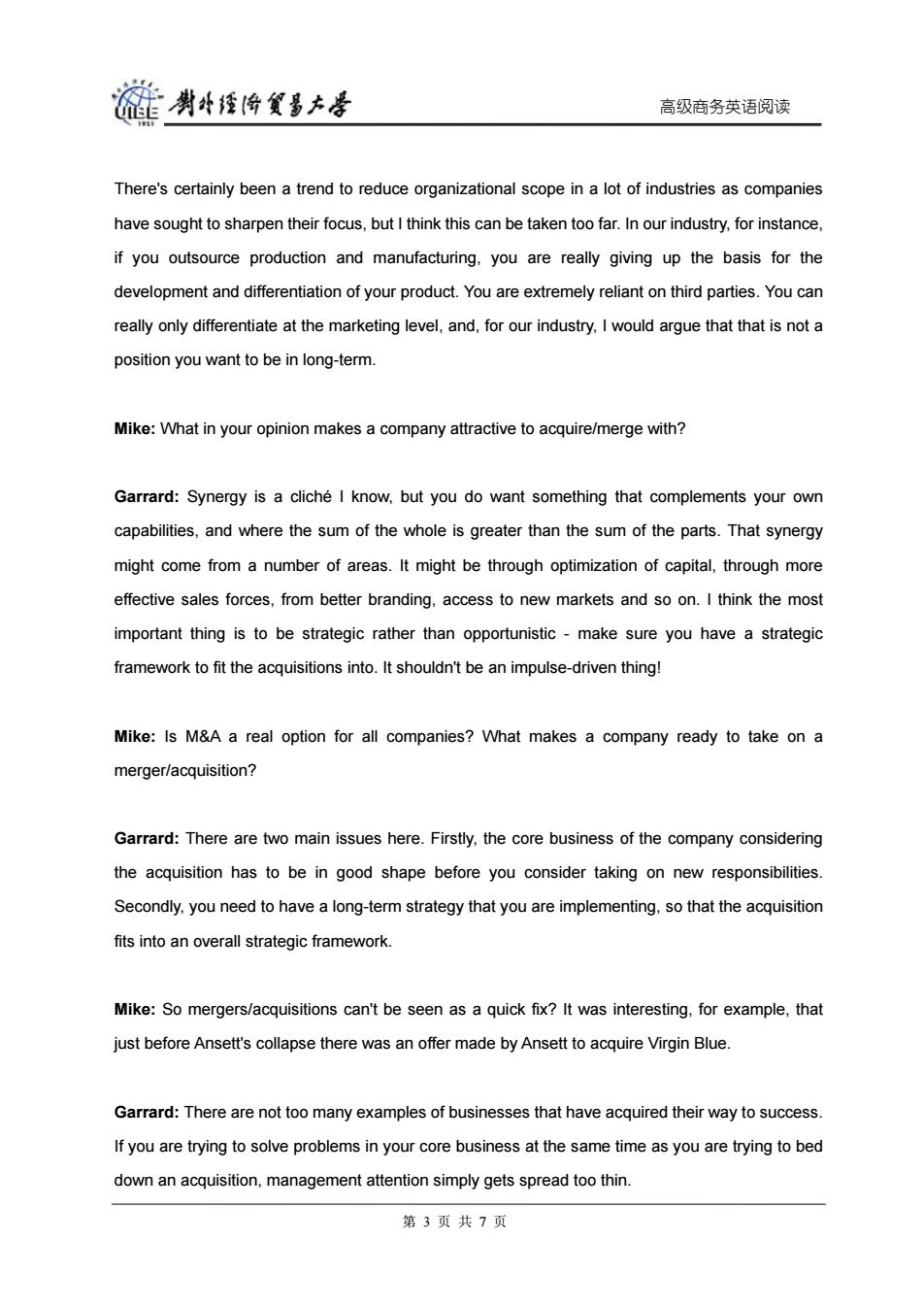
能男华经降贸多大星 高级商务英语阅读 There's certainly been a trend to reduce organizational scope in a lot of industries as companies have sought to sharpen their focus,but I think this can be taken too far.In our industry,for instance. if you outsource production and manufacturing,you are really giving up the basis for the development and differentiation of your product.You are extremely reliant on third parties.You can really only differentiate at the marketing level,and,for our industry,I would argue that that is not a position you want to be in long-term. Mike:What in your opinion makes a company attractive to acquire/merge with? Garrard:Synergy is a cliche I know,but you do want something that complements your own capabilities,and where the sum of the whole is greater than the sum of the parts.That synergy might come from a number of areas.It might be through optimization of capital,through more effective sales forces,from better branding,access to new markets and so on.I think the most important thing is to be strategic rather than opportunistic-make sure you have a strategic framework to fit the acquisitions into.It shouldn't be an impulse-driven thing! Mike:Is M&Aa real option for all companies?What makes a company ready to take on a merger/acquisition? Garrard:There are two main issues here.Firstly,the core business of the company considering the acquisition has to be in good shape before you consider taking on new responsibilities. Secondly,you need to have a long-term strategy that you are implementing,so that the acquisition fits into an overall strategic framework. Mike:So mergers/acquisitions can't be seen as a quick fix?It was interesting,for example,that just before Ansett's collapse there was an offer made by Ansett to acquire Virgin Blue. Garrard:There are not too many examples of businesses that have acquired their way to success. If you are trying to solve problems in your core business at the same time as you are trying to bed down an acquisition,management attention simply gets spread too thin. 第3页共7页
高级商务英语阅读 There's certainly been a trend to reduce organizational scope in a lot of industries as companies have sought to sharpen their focus, but I think this can be taken too far. In our industry, for instance, if you outsource production and manufacturing, you are really giving up the basis for the development and differentiation of your product. You are extremely reliant on third parties. You can really only differentiate at the marketing level, and, for our industry, I would argue that that is not a position you want to be in long-term. Mike: What in your opinion makes a company attractive to acquire/merge with? Garrard: Synergy is a cliché I know, but you do want something that complements your own capabilities, and where the sum of the whole is greater than the sum of the parts. That synergy might come from a number of areas. It might be through optimization of capital, through more effective sales forces, from better branding, access to new markets and so on. I think the most important thing is to be strategic rather than opportunistic - make sure you have a strategic framework to fit the acquisitions into. It shouldn't be an impulse-driven thing! Mike: Is M&A a real option for all companies? What makes a company ready to take on a merger/acquisition? Garrard: There are two main issues here. Firstly, the core business of the company considering the acquisition has to be in good shape before you consider taking on new responsibilities. Secondly, you need to have a long-term strategy that you are implementing, so that the acquisition fits into an overall strategic framework. Mike: So mergers/acquisitions can't be seen as a quick fix? It was interesting, for example, that just before Ansett's collapse there was an offer made by Ansett to acquire Virgin Blue. Garrard: There are not too many examples of businesses that have acquired their way to success. If you are trying to solve problems in your core business at the same time as you are trying to bed down an acquisition, management attention simply gets spread too thin. 第 3 页 共 7 页
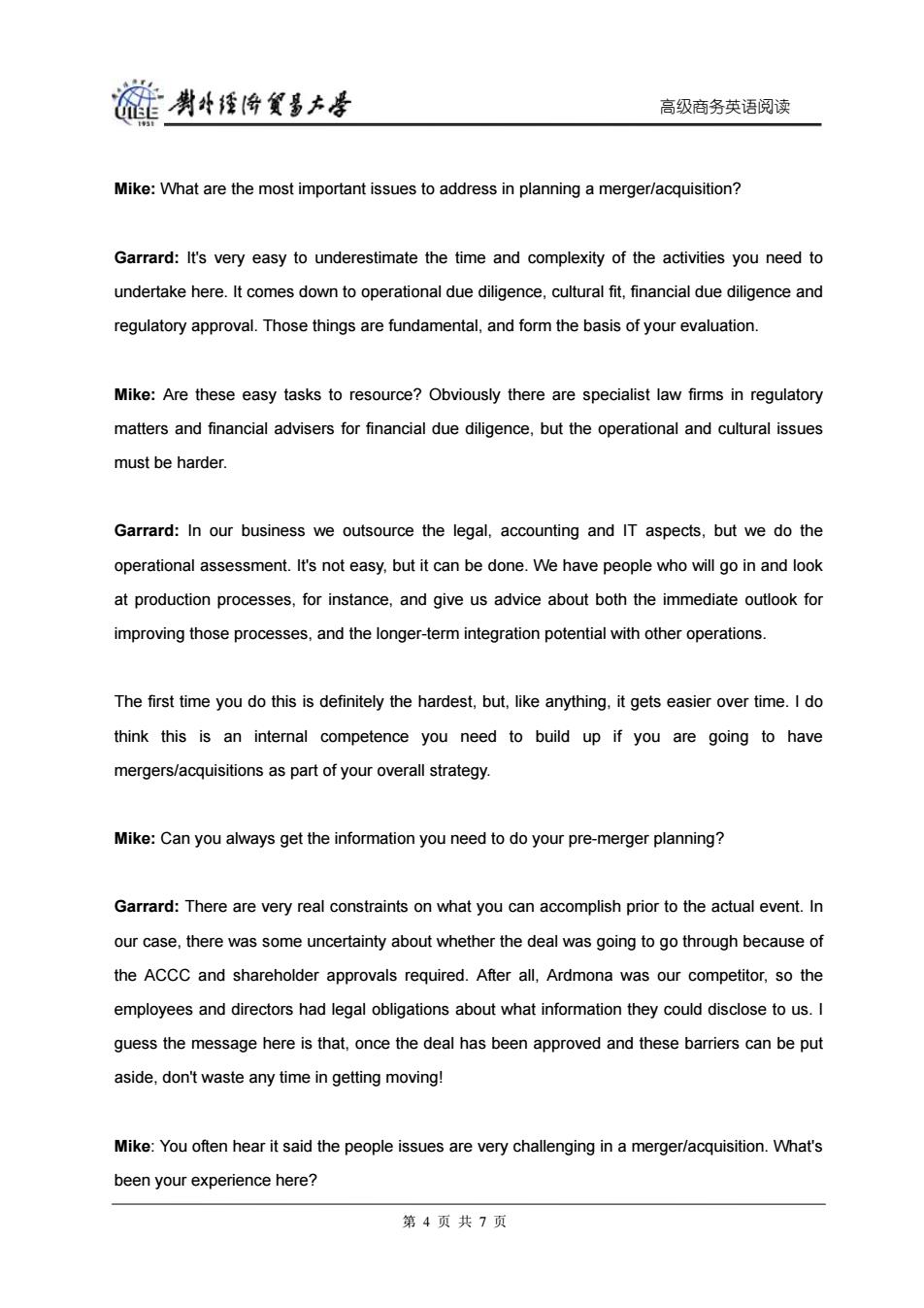
链男牛经海食多大学 高级商务英语阅读 Mike:What are the most important issues to address in planning a merger/acquisition? Garrard:It's very easy to underestimate the time and complexity of the activities you need to undertake here.It comes down to operational due diligence,cultural fit,financial due diligence and regulatory approval.Those things are fundamental,and form the basis of your evaluation. Mike:Are these easy tasks to resource?Obviously there are specialist law firms in regulatory matters and financial advisers for financial due diligence,but the operational and cultural issues must be harder. Garrard:In our business we outsource the legal,accounting and IT aspects,but we do the operational assessment.It's not easy,but it can be done.We have people who will go in and look at production processes,for instance,and give us advice about both the immediate outlook for improving those processes,and the longer-term integration potential with other operations. The first time you do this is definitely the hardest,but,like anything,it gets easier over time.I do think this is an internal competence you need to build up if you are going to have mergers/acquisitions as part of your overall strategy. Mike:Can you always get the information you need to do your pre-merger planning? Garrard:There are very real constraints on what you can accomplish prior to the actual event.In our case,there was some uncertainty about whether the deal was going to go through because of the ACCC and shareholder approvals required.After all,Ardmona was our competitor,so the employees and directors had legal obligations about what information they could disclose to us.I guess the message here is that,once the deal has been approved and these barriers can be put aside,don't waste any time in getting moving! Mike:You often hear it said the people issues are very challenging in a merger/acquisition.What's been your experience here? 第4页共7页
高级商务英语阅读 Mike: What are the most important issues to address in planning a merger/acquisition? Garrard: It's very easy to underestimate the time and complexity of the activities you need to undertake here. It comes down to operational due diligence, cultural fit, financial due diligence and regulatory approval. Those things are fundamental, and form the basis of your evaluation. Mike: Are these easy tasks to resource? Obviously there are specialist law firms in regulatory matters and financial advisers for financial due diligence, but the operational and cultural issues must be harder. Garrard: In our business we outsource the legal, accounting and IT aspects, but we do the operational assessment. It's not easy, but it can be done. We have people who will go in and look at production processes, for instance, and give us advice about both the immediate outlook for improving those processes, and the longer-term integration potential with other operations. The first time you do this is definitely the hardest, but, like anything, it gets easier over time. I do think this is an internal competence you need to build up if you are going to have mergers/acquisitions as part of your overall strategy. Mike: Can you always get the information you need to do your pre-merger planning? Garrard: There are very real constraints on what you can accomplish prior to the actual event. In our case, there was some uncertainty about whether the deal was going to go through because of the ACCC and shareholder approvals required. After all, Ardmona was our competitor, so the employees and directors had legal obligations about what information they could disclose to us. I guess the message here is that, once the deal has been approved and these barriers can be put aside, don't waste any time in getting moving! Mike: You often hear it said the people issues are very challenging in a merger/acquisition. What's been your experience here? 第 4 页 共 7 页
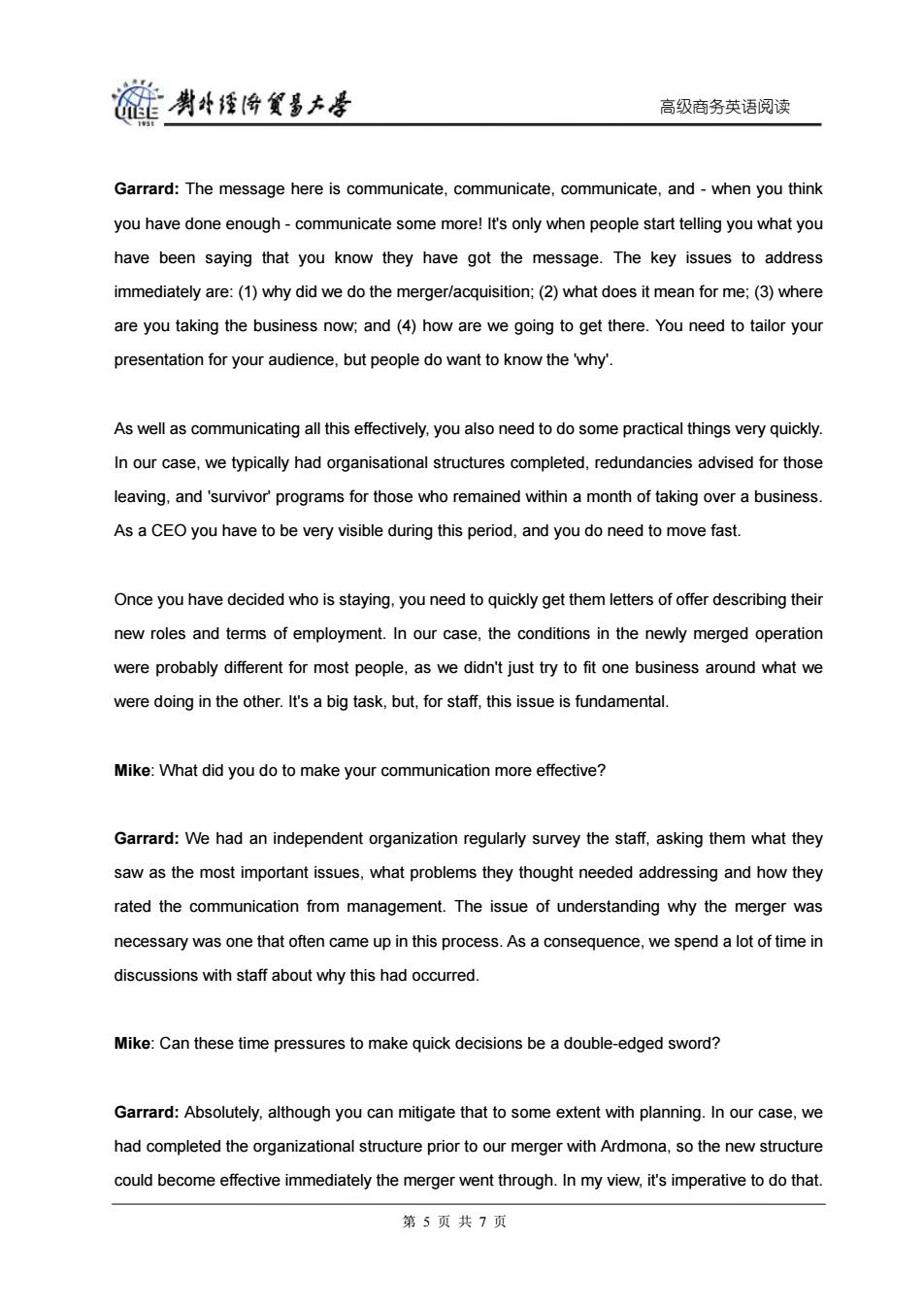
能男华经降贸多大星 高级商务英语阅读 Garrard:The message here is communicate,communicate,communicate,and-when you think you have done enough-communicate some more!It's only when people start telling you what you have been saying that you know they have got the message.The key issues to address immediately are:(1)why did we do the merger/acquisition;(2)what does it mean for me;(3)where are you taking the business now;and(4)how are we going to get there.You need to tailor your presentation for your audience,but people do want to know the 'why'. As well as communicating all this effectively,you also need to do some practical things very quickly. In our case,we typically had organisational structures completed,redundancies advised for those leaving,and 'survivor'programs for those who remained within a month of taking over a business. As a CEO you have to be very visible during this period,and you do need to move fast Once you have decided who is staying,you need to quickly get them letters of offer describing their new roles and terms of employment.In our case,the conditions in the newly merged operation were probably different for most people,as we didn't just try to fit one business around what we were doing in the other.It's a big task,but,for staff,this issue is fundamental. Mike:What did you do to make your communication more effective? Garrard:We had an independent organization regularly survey the staf,asking them what they saw as the most important issues,what problems they thought needed addressing and how they rated the communication from management.The issue of understanding why the merger was necessary was one that often came up in this process.As a consequence,we spend a lot of time in discussions with staff about why this had occurred. Mike:Can these time pressures to make quick decisions be a double-edged sword? Garrard:Absolutely,although you can mitigate that to some extent with planning.In our case,we had completed the organizational structure prior to our merger with Ardmona,so the new structure could become effective immediately the merger went through.In my view,it's imperative to do that. 第5页共7页
高级商务英语阅读 Garrard: The message here is communicate, communicate, communicate, and - when you think you have done enough - communicate some more! It's only when people start telling you what you have been saying that you know they have got the message. The key issues to address immediately are: (1) why did we do the merger/acquisition; (2) what does it mean for me; (3) where are you taking the business now; and (4) how are we going to get there. You need to tailor your presentation for your audience, but people do want to know the 'why'. As well as communicating all this effectively, you also need to do some practical things very quickly. In our case, we typically had organisational structures completed, redundancies advised for those leaving, and 'survivor' programs for those who remained within a month of taking over a business. As a CEO you have to be very visible during this period, and you do need to move fast. Once you have decided who is staying, you need to quickly get them letters of offer describing their new roles and terms of employment. In our case, the conditions in the newly merged operation were probably different for most people, as we didn't just try to fit one business around what we were doing in the other. It's a big task, but, for staff, this issue is fundamental. Mike: What did you do to make your communication more effective? Garrard: We had an independent organization regularly survey the staff, asking them what they saw as the most important issues, what problems they thought needed addressing and how they rated the communication from management. The issue of understanding why the merger was necessary was one that often came up in this process. As a consequence, we spend a lot of time in discussions with staff about why this had occurred. Mike: Can these time pressures to make quick decisions be a double-edged sword? Garrard: Absolutely, although you can mitigate that to some extent with planning. In our case, we had completed the organizational structure prior to our merger with Ardmona, so the new structure could become effective immediately the merger went through. In my view, it's imperative to do that. 第 5 页 共 7 页
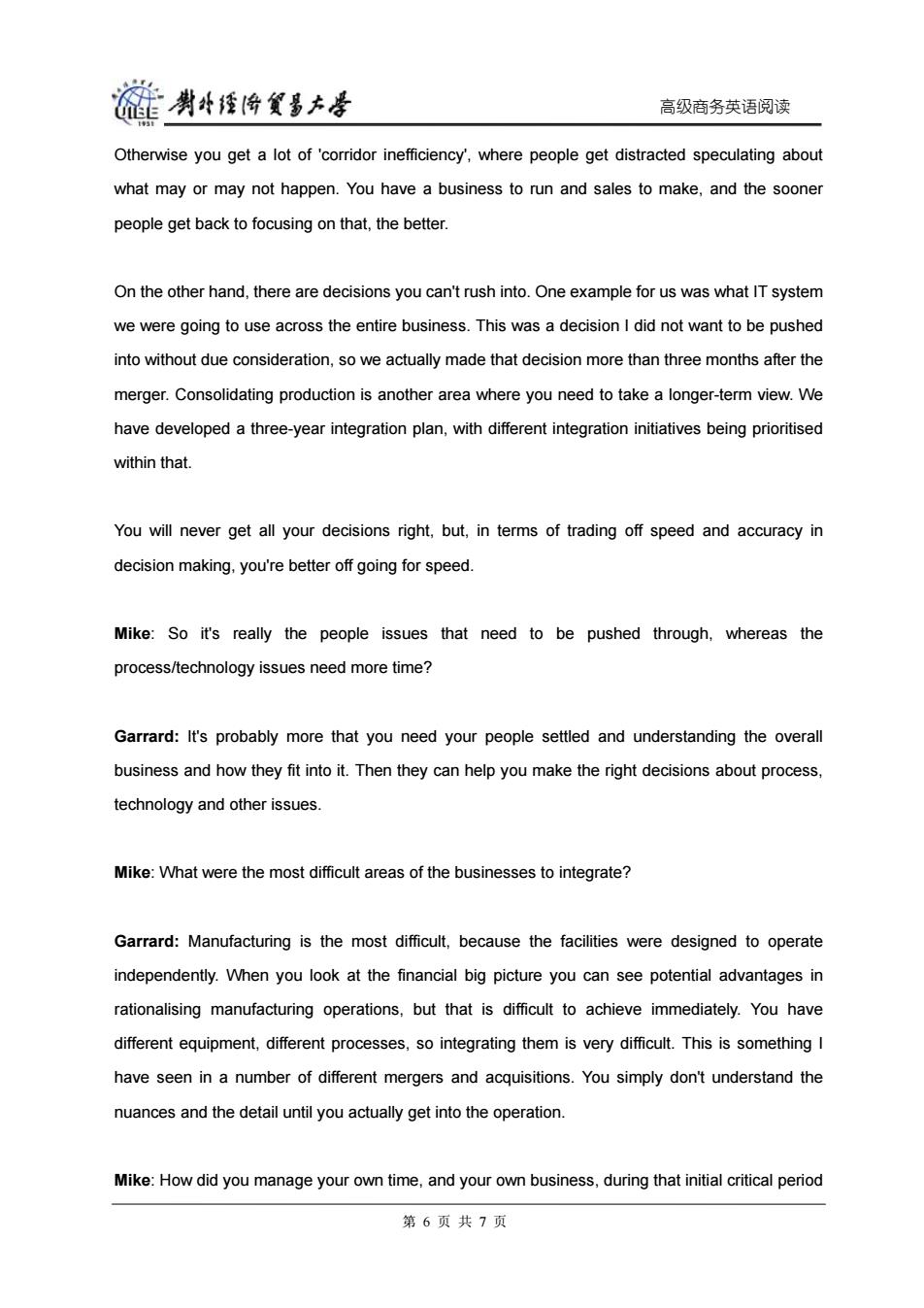
碰男将多大是 高级商务英语阅读 Otherwise you get a lot of 'corridor inefficiency,where people get distracted speculating about what may or may not happen.You have a business to run and sales to make,and the sooner people get back to focusing on that,the better. On the other hand,there are decisions you can't rush into.One example for us was what IT system we were going to use across the entire business.This was a decision I did not want to be pushed into without due consideration,so we actually made that decision more than three months after the merger.Consolidating production is another area where you need to take a longer-term view.We have developed a three-year integration plan,with different integration initiatives being prioritised within that. You will never get all your decisions right,but,in terms of trading off speed and accuracy in decision making,you're better off going for speed. Mike:So it's really the people issues that need to be pushed through,whereas the process/technology issues need more time? Garrard:It's probably more that you need your people settled and understanding the overall business and how they fit into it.Then they can help you make the right decisions about process, technology and other issues. Mike:What were the most difficult areas of the businesses to integrate? Garrard:Manufacturing is the most difficult,because the facilities were designed to operate independently.When you look at the financial big picture you can see potential advantages in rationalising manufacturing operations,but that is difficult to achieve immediately.You have different equipment,different processes,so integrating them is very difficult.This is something I have seen in a number of different mergers and acquisitions.You simply don't understand the nuances and the detail until you actually get into the operation. Mike:How did you manage your own time,and your own business,during that initial critical period 第6页共7页
高级商务英语阅读 Otherwise you get a lot of 'corridor inefficiency', where people get distracted speculating about what may or may not happen. You have a business to run and sales to make, and the sooner people get back to focusing on that, the better. On the other hand, there are decisions you can't rush into. One example for us was what IT system we were going to use across the entire business. This was a decision I did not want to be pushed into without due consideration, so we actually made that decision more than three months after the merger. Consolidating production is another area where you need to take a longer-term view. We have developed a three-year integration plan, with different integration initiatives being prioritised within that. You will never get all your decisions right, but, in terms of trading off speed and accuracy in decision making, you're better off going for speed. Mike: So it's really the people issues that need to be pushed through, whereas the process/technology issues need more time? Garrard: It's probably more that you need your people settled and understanding the overall business and how they fit into it. Then they can help you make the right decisions about process, technology and other issues. Mike: What were the most difficult areas of the businesses to integrate? Garrard: Manufacturing is the most difficult, because the facilities were designed to operate independently. When you look at the financial big picture you can see potential advantages in rationalising manufacturing operations, but that is difficult to achieve immediately. You have different equipment, different processes, so integrating them is very difficult. This is something I have seen in a number of different mergers and acquisitions. You simply don't understand the nuances and the detail until you actually get into the operation. Mike: How did you manage your own time, and your own business, during that initial critical period 第 6 页 共 7 页

碰男将多大是 高级商务英语阅读 after the merger went through? Garrard:I would say that,in the first three months of the period immediately after the merger,70% of my time was spent on integrating the two businesses.We also have a dedicated team headed by a senior manager whose sole responsibility is bedding down the merger,and we expect that to continue for two years.There is a team of three people at the moment,with other people being seconded in on an as-needed basis.A lot of the immediate post-integration tasks,such as outplacement,have been outsourced,so there is also a significant amount of work being done by suppliers that needs to be managed as well. A lot of this qualification and briefing of suppliers needs to be done prior to the merger.With HR,for instance,you need to advise what your redundancy package will be,what outplacement services you will offer,and so on.Information Technology was similar-we had briefed our supplier on what we would need and when we would need it,prior to the merger.You don't want to be seeking out and qualifying suppliers in that period immediately following the merger if you can help it. Mike:From your experience,how is it different running a post-merger company,compared to running the company beforehand? Garrard:You are trying to blend two cultures,and you have a responsibility to set an example.To accelerate that process,I created teams that were deliberately chosen to have representation from both businesses.With the marketing and sales people,I had them working together in the one office within four weeks.We have also done a number of team-building activities to get everyone working well together.There's a lot more to do,of course,but our results so far are pleasing. 第7页共7页
高级商务英语阅读 after the merger went through? Garrard: I would say that, in the first three months of the period immediately after the merger, 70% of my time was spent on integrating the two businesses. We also have a dedicated team headed by a senior manager whose sole responsibility is bedding down the merger, and we expect that to continue for two years. There is a team of three people at the moment, with other people being seconded in on an as-needed basis. A lot of the immediate post-integration tasks, such as outplacement, have been outsourced, so there is also a significant amount of work being done by suppliers that needs to be managed as well. A lot of this qualification and briefing of suppliers needs to be done prior to the merger. With HR, for instance, you need to advise what your redundancy package will be, what outplacement services you will offer, and so on. Information Technology was similar - we had briefed our supplier on what we would need and when we would need it, prior to the merger. You don't want to be seeking out and qualifying suppliers in that period immediately following the merger if you can help it. Mike: From your experience, how is it different running a post-merger company, compared to running the company beforehand? Garrard: You are trying to blend two cultures, and you have a responsibility to set an example. To accelerate that process, I created teams that were deliberately chosen to have representation from both businesses. With the marketing and sales people, I had them working together in the one office within four weeks. We have also done a number of team-building activities to get everyone working well together. There's a lot more to do, of course, but our results so far are pleasing. 第 7 页 共 7 页